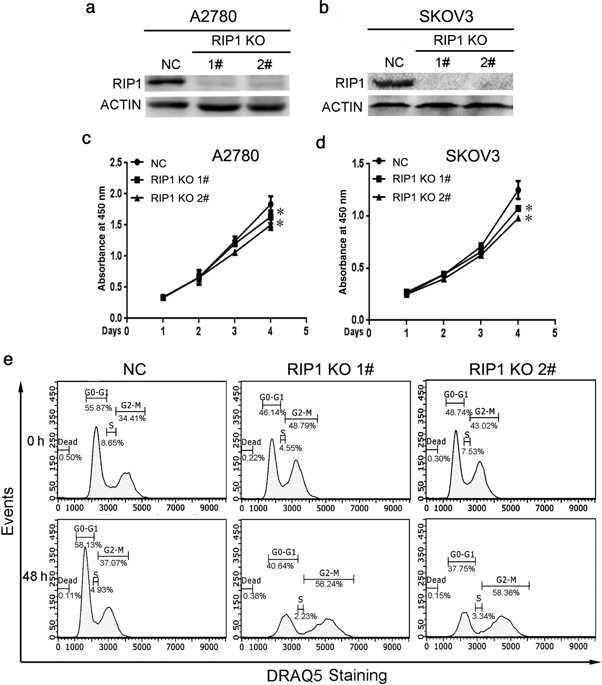Acta Pharmacologica Sinica ( IF 8.2 ) Pub Date : 2020-04-02 , DOI: 10.1038/s41401-019-0340-7 Xue-Lian Zheng 1 , Jiao-Jiao Yang 2 , Yan-Yun Wang 1 , Qin Li 1 , Ya-Ping Song 1 , Min Su 1 , Jin-Ke Li 1 , Lin Zhang 1 , Zhi-Ping Li 2 , Bin Zhou 1 , Yong Lin 3

|
Receptor-interacting protein 1 (RIP1, also known as RIPK1) is not only a tumor-promoting factor in several cancers but also mediates either apoptosis or necroptosis in certain circumstances. In this study we investigated what role RIP1 plays in human ovarian cancer cells. We showed that knockout (KO) of RIP1 substantially suppressed cell proliferation, accompanied by the G2/M checkpoint arrest in two human ovarian cancer cell lines SKOV3 and A2780. On the other hand, RIP1 KO remarkably attenuated cisplatin-induced cytotoxicity, which was associated with reduction of the apoptosis markers PARP cleavage and the necroptosis marker phospho-MLKL. We found that RIP1 KO suppressed cisplatin-induced ROS accumulation in both SKOV3 and A2780 cells. ROS scavenger BHA, apoptosis inhibitor Z-VAD or necroptosis inhibitor NSA could effectively suppress cisplatin’s cytotoxicity in the control cells, suggesting that ROS-mediated apoptosis and necroptosis were involved in cisplatin-induced cell death. In addition, blocking necroptosis with MLKL siRNA effectively attenuated cisplatin-induced cytotoxicity. In human ovarian cancer A2780 cell line xenograft nude mice, RIP1 KO not only significantly suppressed the tumor growth but also greatly attenuated cisplatin’s anticancer activity. Our results demonstrate a dual role of RIP1 in human ovarian cancer: it acts as either a tumor-promoting factor to promote cancer cell proliferation or a tumor-suppressing factor to facilitate anticancer effects of chemotherapeutics such as cisplatin.
中文翻译:

RIP1通过G2 / M检查点进程促进增殖,并介导顺铂诱导的人卵巢癌细胞凋亡和坏死性坏死。
受体相互作用蛋白1(RIP1,也称为RIPK1)不仅是几种癌症的肿瘤促进因子,而且在某些情况下还介导凋亡或坏死性坏死。在这项研究中,我们调查了RIP1在人类卵巢癌细胞中的作用。我们显示RIP1的敲除(KO)基本上抑制了细胞增殖,并伴随着两个人类卵巢癌细胞系SKOV3和A2780的G2 / M检查点停滞。另一方面,RIP1 KO显着减弱了顺铂诱导的细胞毒性,这与凋亡标记物PARP裂解和坏死性标记物磷酸化MLKL的减少有关。我们发现RIP1 KO抑制了顺铂诱导的ROS在SKOV3和A2780细胞中的蓄积。ROS清除剂BHA,凋亡抑制剂Z-VAD或坏死病抑制剂NSA可以有效抑制顺铂在对照细胞中的细胞毒性,提示ROS介导的凋亡和坏死病参与了顺铂诱导的细胞死亡。此外,用MLKL siRNA阻断坏死病可有效减弱顺铂诱导的细胞毒性。在人卵巢癌A2780细胞系异种移植裸鼠中,RIP1 KO不仅显着抑制了肿瘤的生长,而且大大减弱了顺铂的抗癌活性。我们的结果证明RIP1在人类卵巢癌中具有双重作用:它既可以作为促进癌细胞增殖的肿瘤促进因子,也可以作为促进化学疗法(如顺铂)的抗癌作用的肿瘤抑制因子。提示ROS介导的细胞凋亡和坏死性坏死与顺铂诱导的细胞死亡有关。此外,用MLKL siRNA阻断坏死病可有效减弱顺铂诱导的细胞毒性。在人类卵巢癌A2780细胞系异种移植裸鼠中,RIP1 KO不仅显着抑制了肿瘤的生长,而且大大减弱了顺铂的抗癌活性。我们的结果证明RIP1在人类卵巢癌中具有双重作用:它既可以作为促进癌细胞增殖的肿瘤促进因子,也可以作为促进化学疗法(如顺铂)的抗癌作用的肿瘤抑制因子。提示ROS介导的细胞凋亡和坏死性坏死与顺铂诱导的细胞死亡有关。此外,用MLKL siRNA阻断坏死病可有效减弱顺铂诱导的细胞毒性。在人卵巢癌A2780细胞系异种移植裸鼠中,RIP1 KO不仅显着抑制了肿瘤的生长,而且大大减弱了顺铂的抗癌活性。我们的结果证明RIP1在人类卵巢癌中具有双重作用:它既可以作为促进癌细胞增殖的肿瘤促进因子,也可以作为促进化学疗法(如顺铂)的抗癌作用的肿瘤抑制因子。RIP1 KO不仅显着抑制了肿瘤的生长,而且大大减弱了顺铂的抗癌活性。我们的结果证明RIP1在人类卵巢癌中具有双重作用:它既可以作为促进癌细胞增殖的肿瘤促进因子,也可以作为促进化学疗法(如顺铂)的抗癌作用的肿瘤抑制因子。RIP1 KO不仅显着抑制了肿瘤的生长,而且大大减弱了顺铂的抗癌活性。我们的结果证明RIP1在人类卵巢癌中具有双重作用:它既可以作为促进癌细胞增殖的肿瘤促进因子,也可以作为促进化学疗法(如顺铂)的抗癌作用的肿瘤抑制因子。


























 京公网安备 11010802027423号
京公网安备 11010802027423号